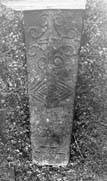Select a site alphabetically from the choices shown in the box below. Alternatively, browse sculptural examples using the Forward/Back buttons.
Chapters for this volume, along with copies of original in-text images, are available here.
Object type: Grave-cover
Measurements: L. 75 cm (29.5 in) W. 32 > 19 cm (12.6 > 7.5 in) D. > 8 cm (3.1 in)
Stone type: [Ancaster Freestone, Upper Lincolnshire Limestone, Inferior Oolite Group]
Plate numbers in printed volume: Ill. 429
Corpus volume reference: Vol 5 p. 290
(There may be more views or larger images available for this item. Click on the thumbnail image to view.)
A coped, tapered, grave-cover with decoration in low relief on one face.
A (top): A centrally placed cross with a stepped base and a floreate cross-head (cf. Butler 1964, fig. 4C). The centre of the shaft is decorated with a lozenge, the shape of which is repeated in two incised lines within the raised area.
Appendix A item (stones dating from Saxo-Norman overlap period or of uncertain date).
This grave-cover is included here because of the presence of the lozenge, which is of exactly the same type as that on Crowland (Abbey) 1 (Ill. 143) and is also found on various monuments in Cambridgeshire. Taking these two late grave-covers together, the implication must be that the 'bull's head' motif (which occurs on the Crowland grave-cover) and the floreate cross (on this from Sleaford) both occur alongside the same incised lozenge decoration and cannot, therefore, be widely separated in date. The cross-head on the Sleaford cover dates it quite firmly to the twelfth century (Butler 1964, 125), there being many parallel examples both in Lincolnshire and elsewhere in the East Midlands. The Crowland cover, on the other hand, is more likely to belong to the late eleventh century; so, between the two monuments, lozenges of this sort would seem to be a feature of the decades either side of 1100.



